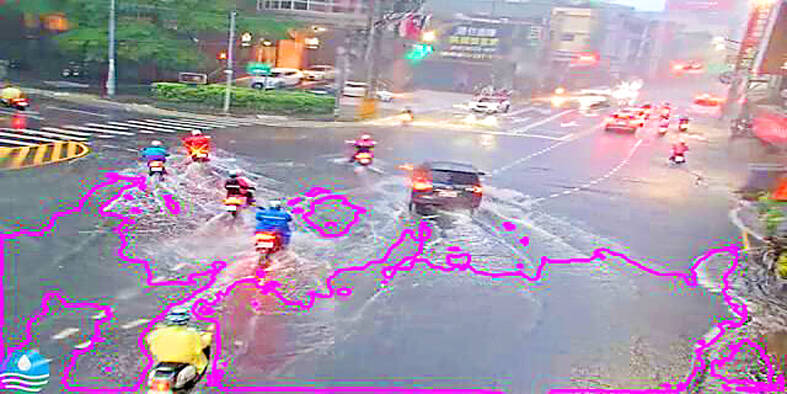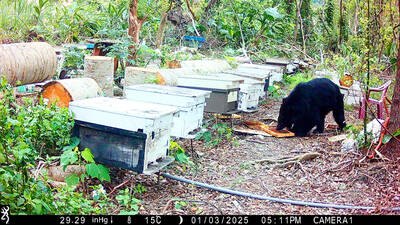The Executive Yuan has approved a NT$3.09 billion (US$94.1 million) plan to use artificial intelligence (AI) to manage flooding risks from typhoons and other weather events, the Water Resources Agency said yesterday.
The program, which is to run from next year to 2029, would utilize advances in AI, fifth-generation telecom networks, the Internet of Things and pattern recognition to upgrade disaster-response capabilities, including through risk spatialization and augmented decisionmaking, as well as by increasing the number of monitoring stations to 1,200 nationwide, the agency said.
The program would launch mobile apps to improve first-responder communications and coordination, and improve awareness of climate risks among the public, it said

Photo courtesy of the Water Resources Agency
Novel technologies introduced by the program’s previous iteration from 2020 to this year boosted the agency’s ability to detect flooding hazards six hours in advance, it said.
The agency uses an AI-based monitoring system that analyzes data from 2,072 flood detectors and 8,769 cameras, it said, adding that it has 1,676 mobile water pumps, 19,500 flood barrier sections, 544 community-based independent flood management units and 1,477 volunteers.
The government has created partnerships with private enterprises to create a joint natural disaster response capability, the agency said, adding that it has accomplished the government’s preliminary targets for smart disaster relief capability and infrastructure construction.

SHIPS, TRAINS AND AUTOMOBILES: The ministry has announced changes to varied transportation industries taking effect soon, with a number of effects for passengers Beginning next month, the post office is canceling signature upon delivery and written inquiry services for international registered small packets in accordance with the new policy of the Universal Postal Union, the Ministry of Transportation and Communications said yesterday. The new policy does not apply to packets that are to be delivered to China, the ministry said. Senders of international registered small packets would receive a NT$10 rebate on postage if the packets are sent from Jan. 1 to March 31, it added. The ministry said that three other policies are also scheduled to take effect next month. International cruise ship operators

HORROR STORIES: One victim recounted not realizing they had been stabbed and seeing people bleeding, while another recalled breaking down in tears after fleeing A man on Friday died after he tried to fight the knife-wielding suspect who went on a stabbing spree near two of Taipei’s busiest metro stations, Taipei Mayor Chiang Wan-an (蔣萬安) said. The 57-year-old man, identified by his family name, Yu (余), encountered the suspect at Exit M7 of Taipei Main Station and immediately tried to stop him, but was fatally wounded and later died, Chiang said, calling the incident “heartbreaking.” Yu’s family would receive at least NT$5 million (US$158,584) in compensation through the Taipei Rapid Transit Corp’s (TRTC) insurance coverage, he said after convening an emergency security response meeting yesterday morning. National

PLANNED: The suspect visited the crime scene before the killings, seeking information on how to access the roof, and had extensively researched a 2014 stabbing incident The suspect in a stabbing attack that killed three people and injured 11 in Taipei on Friday had planned the assault and set fires at other locations earlier in the day, law enforcement officials said yesterday. National Police Agency (NPA) Director-General Chang Jung-hsin (張榮興) said the suspect, a 27-year-old man named Chang Wen (張文), began the attacks at 3:40pm, first setting off smoke bombs on a road, damaging cars and motorbikes. Earlier, Chang Wen set fire to a rental room where he was staying on Gongyuan Road in Zhongzheng District (中正), Chang Jung-hsin said. The suspect later threw smoke grenades near two exits

The Forestry and Nature Conservation Agency yesterday launched a gift box to market honey “certified by a Formosan black bear” in appreciation of a beekeeper’s amicable interaction with a honey-thieving bear. Beekeeper Chih Ming-chen (池明鎮) in January inspected his bee farm in Hualien County’s Jhuosi Township (卓溪) and found that more than 20 beehives had been destroyed and many hives were eaten, with bear droppings and paw prints near the destroyed hives, the agency said. Chih returned to the farm to move the remaining beehives away that evening when he encountered a Formosan black bear only 20m away, the agency said. The bear